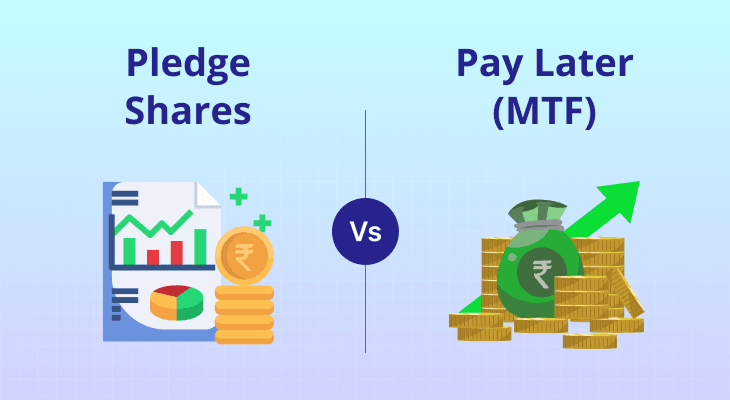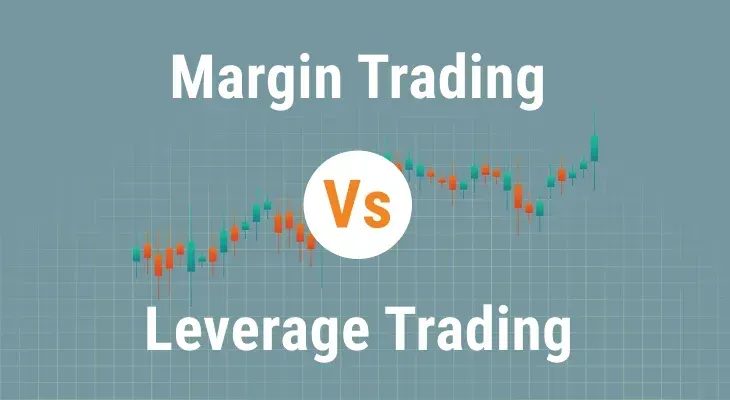
What is the Charge on Pledging?
Margin Trading Facility (MTF) is a popular trading strategy through which you can borrow money from your broker to buy shares that you could not have afforded using your own capital. In MTF, pledging shares is a common practice used by investors to secure loans or obtain a margin in trading. By pledging shares, you offer your existing stock holdings as collateral for borrowing. While it is a convenient way to access funds or margin, it comes with some costs. Understanding these pledge charges, also known as margin pledge charges, or stock pledge charges, is vital for managing your investment portfolio effectively.
What is Share Pledging?
Share pledging involves offering your owned shares as collateral to brokers or financial institutions to secure loans or margins. Once pledged, these shares serve as a guarantee for borrowing money or trading on margins, allowing you to take larger positions in the market. If you fail to meet the agreed terms, the lender has the right to sell the pledged shares to recover the loan or margin provided.
Meaning of "Haircut" in Pledging?
The haircut refers to the percentage reduction in the market value of your pledged shares. This reduction is applied to calculate the actual margin that can be used. For example, if a share has a market value of ₹ 100 and a 20% haircut is applied, only ₹ 80 will be considered when determining your margin. Haircuts protect the lender against fluctuations in stock prices. This haircut can be a flat percentage or levied based upon your trading history and the broker’s policies.
When is the Margin Received?
Once you pledge your shares, the margin is usually credited to your account within one working day, depending on the broker or institution you’re dealing with. The speed of receiving the margin depends on factors such as the stock exchange where your shares are traded and the broker's internal processing time. This immediate availability of margin makes pledging a popular choice among traders who want quick access to funds.
Most brokers allow you to pledge multiple types of securities, including equities, mutual funds, and exchange-traded funds (ETFs). However, the maximum number of different holdings you can pledge may vary from broker to broker. While there’s no universal limit, some brokers may impose restrictions based on their internal risk management guidelines.
Why You Maybe Unable to Pledge Your Holdings?
There could be several reasons why you’re unable to pledge your holdings:
- Unapproved Stocks: Some stocks might not be eligible for pledging.
- Existing Liens or Blockages: Shares already used as collateral for other loans may be restricted.
- Incomplete Documentation: If your KYC or trading account is not properly verified, pledging might be blocked.
- Inactive or Delisted Stocks: If a stock is inactive or delisted from the exchange, it cannot be pledged for a margin.
Charges of Pledging Shares
Pledging shares comes with specific charges that vary across brokers and institutions. The typical pledge charges include:
- Pledge creation charges: These are one-time fees that are incurred while pledging your shares. They can range between ₹30 to ₹60 per transaction. Online discount brokers like m.Stock levy very low stock pledge charges and even the pledge shares interest rate is as low as 0.033% per day.
- Pledge revocation charges: If you decide to revoke or remove the pledge, there may be additional fees.
- Maintenance or holding charges: Some brokers may levy periodic charges for maintaining the pledge, though this is less common.
Naturally, it is in your interest to select a broker that has low margin pledge charges so that you can retain most of your profits.
Things to Note/Consider Before Pledging Shares
Before pledging shares, consider the following:
- Stock Volatility: Highly volatile stocks may require a larger margin or higher haircut, increasing risk.
- Interest and Charges: Review the cumulative cost of interest, pledge charges, and other fees associated with pledging.
- Risk of Loss: If the market value of pledged shares drops significantly, you may need to provide additional collateral.
- Pledge-Eligible Stocks: Not all stocks are eligible for pledging, especially those that are illiquid or have been recently delisted.
- Exit Strategy: Make sure you have an exit plan in case the pledged shares are sold due to non-repayment or market fluctuations.
Another aspect to keep in mind is liquidity. When you pledge shares, you lose access to their liquidity since they’re held as collateral by the broker. This means you cannot sell these shares unless the pledge is released, even if the market price increases. Furthermore, if the stock price declines significantly, the lender may ask for additional margins, putting more pressure on you. Therefore, while pledging provides access to margin, it limits your ability to react to market changes by liquidating your pledged holdings.
FAQ
What should I consider before pledging shares?
Before pledging, evaluate the haircut percentage, applicable charges, the volatility of your pledged shares, and whether you can meet margin calls if your stock value decreases. Ensure you understand the risks involved.
What is share pledging?
Share pledging involves using your shares as collateral to borrow funds or margins and take larger positions in the market. The shares remain in your account, but they are locked, and you cannot sell them until the pledge is released.
What are pledge charges?
Pledge charges are fees levied by brokers or financial institutions when you pledge your shares as collateral. These fees cover the processing of the pledge and are typically charged per transaction or per security.
What is a "haircut" in pledge?
A "haircut" refers to the discount applied to the value of pledged securities. For example, if the haircut is 20%, you can only borrow 80% of the stock's current value as margin.
When do I receive the margin after pledging my shares?
After you pledge your shares, the margin is generally credited to your trading account within one working day, depending on the broker's processes and verification times.
Why can’t I pledge my holdings?
Your inability to pledge holdings might be due to the stock not being eligible for pledging, technical issues with your broker, or restrictions set by the exchange on the specific stock or type of holding.
What are the charges for pledging shares?
Pledge charges vary but typically include processing fees, annual maintenance, and GST. The exact charges depend on the broker or institution and may range between ₹ 25 to ₹ 100 per security.
What is the maximum number of different holdings I can pledge?
There is no universal limit to how many holdings you can pledge, but each pledge may incur separate charges, and eligibility depends on the broker’s policies and market rules.
What happens if the value of pledged shares falls?
If the value of your pledged shares goes below the required margin, your broker may issue a margin call, requiring you to deposit additional funds or securities to cover the shortfall.
Can I sell pledged shares?
No, pledged shares are locked and cannot be sold until the pledge is removed. You need to repay the margin or loan amount first to unpledge the shares.


